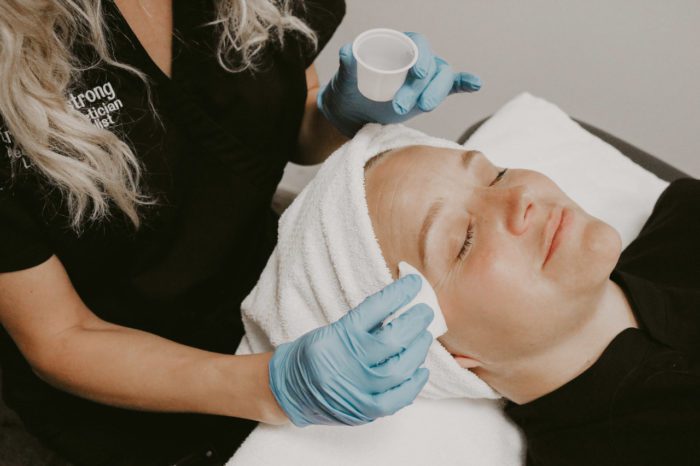
A chemical peel may sound intimidating. However, once you try one and see the results, you’ll likely want to book your next appointment ASAP.
Chemical peels are very popular because they are a fantastic treatment for a number of different skin concerns. Plus, they can be customized to your specific needs by a wide variety of solutions and solution intensity. With all the treatment options available, you may not know which peel is best for you. So, we’ve outlined everything you need to know about chemical peels and armed you with the information you need to decide which peel may be right for you. Let’s dive in . . .
What is a Chemical Peel?
A chemical peel is a skin treatment used to remove signs of aging, reduce pore size, improve sun damage and increase your skin’s natural radiance. Peels use a chemical solution applied to the face to remove the outermost layers of dead skin and leave behind soft, glowing new layers of skin. This process stimulates new cell growth as well as ramping up the production of collagen.
There are three main types of chemical peels, with each being defined by their intensity or depth of skin that are affected by the treatment.
-
Light Chemical Peel
A light chemical peel, also known as a superficial peel, only affects the top layer of the skin. In this case, the peel solution will only be on the skin for a couple of minutes. Superficial peels usually use Alpha Hydroxy acid or Beta Hydroxy acid. Alpha Hydroxy is one of the mildest chemical peels you can try, while Beta Hydroxy helps to control oil production in the skin. You can also try the Jessner Peel for a similar, light treatment option.
The pros of a light peel are that they are gentle on the skin and have almost instant results, so if you need a quick refresh, this is a fantastic option.
All chemical peels can lead to dryness, so your aesthetician will advise you about moisturization options to keep your skin hydrated after the treatment is completed.
2. Medium Chemical Peel
A medium-depth chemical peel will penetrate the first layer of the skin and target problems that may be hiding under the surface. This treatment is perfect for those that have lasting sun damage, deep wrinkles, or issues such as acne scars.
Medium peels can be customized and include a wide variety of solution offerings, but typically require 3-7 days of downtime afterward. That said, medium peels target and correct deeper skin issues than can be corrected by a light peel.
3. Deep Chemical Peel
Deep peels are the most intense types of chemical peels and target deep-seated skin issues. Since these peels are much more intense than the other two, they typically require at least 7-10 days of downtime. You can expect peeling and increased redness for up to 2 weeks after your procedure.
While the downtime may seem like a lot, deep peel results may be worth it. The results of deep chemical peels are truly long lasting, with some reporting their results have lasted for years after their treatment.
Chemical peels are one of the most effective skin treatments you can try. Whether you want to address long-term skin issues with a deep peel like the ZO 3 Step Peel or just want to rejuvenate your skin’s natural glow, there is a chemical peel that will work for you. It is essential to work with your aesthetician to book a pre-peel consultation to determine which products and treatments are right for your skin. To learn more and book a pre-peel consultation, simply contact our office at 615-814-4999.